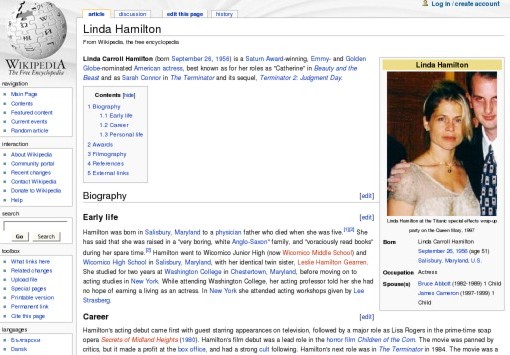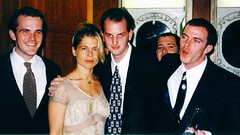Peter and Linda, Together at Last on Wikipedia
Look carefully at the Wikipedia page on Linda Hamilton. Notice anything strange about the photo? Yes, that is my friend Peter who has his arm around her. Though I am an occasional Wikipdia contributor, I had nothing to do with this. Peter is thrilled to be in this position and calls it a “Christmas miracle”. How could such a thing happen?
It starts back in 1997. My friend Zach was just starting his career in special effects. He had just finished up work on was a small independent film, The Titanic. Maybe you’ve heard of it? The crew was having a wrap party on the Queen Mary, and somehow Zach convinced his employer to let him take a handful of his scruffy friends to the party instead of a date. James Cameron, the director, was there with a real date, actress Linda Hamilton. The details are debated, but at some point in the night someone started a conversation with her, producing many awkward moments and a photo.
Fast forward to 2007. Flickr, where I host my photos these days, introduces a new stats feature. In addition to the number of times someone views one of your photos, they now also record the referer. Most web browsers, when loading a new page, will tell the page the last page it was on. That is, you can often tell the last page a visitor was on before he arrived at your site. I noticed a bunch of traffic coming from Wikipedia and investigated.
The visitors were arriving at this group picture with Linda Hamilton from her entry’s talk page. Every page on Wikipedia has a companion talk page (which you can access via the “discussion” link at the top of each page) where contributors can chat without muddying the page itself. They had conducted a long debate about fair use. Wikipedia’s goal is to create a free encyclopedia. Not just free to read, but free for anyone to use anyway they want. (Free as in free speech, not just free as in free beer.) As such, they’re very concerned about including content, including images, that have are under normal copyright. In 1989, the United States adopted the Berne Convention, which automatically puts anything you produce under copyright. On top of that, copyrights in the United States now last at least 70 years (usually much longer). This makes it tricky for Wikipedia contributors to find content they know is safe to use.
I’m happy to have people reuse my photographs. Creative Commons is an organization that wants to make it possible for non-lawyers like myself to say this in a legally-valid-type way. They developed a suite of licenses to help. You can choose under which conditions you’ll allow people to reuse your work. Flickr makes it easy to select the one you like for your photos, creating huge collection of images that people or projects can reuse in their own work without fear of being sued. I’ve released all my photos under the Attribution license, the most permissive license, which says “do what you want but give me credit”. This allowed the Wikipedia contributor to crop my photo down to (mostly) Linda and to upload it to Wikipedia. They credit me by giving my name and a link to the original on the image’s detail page.
And create a Christmas miracle.


Peter posted on 2008-03-01 (source):
Special thanks to Zach for getting us at the party. I'm sure the expression on his face in the original picture is "Ya Sure, I spend months slaving over Titanic shadows rendering and making coffee for Cameron, smuggle my friends into this wrap party, engineer an encounter with the lovely Linda Hamilton and you guys take alpha position away from me!". In the picture left-to-right: Matt, Linda, Peter, Zach. River in background. JT snapping the shutter. Never understimate the power of the Christmas Miracle.Kirstin posted on 2008-03-01 (source):
Interesting! Great blog btw...Evelyn posted on 2008-03-04 (source):
I had always wondered what the story behind that picture was...